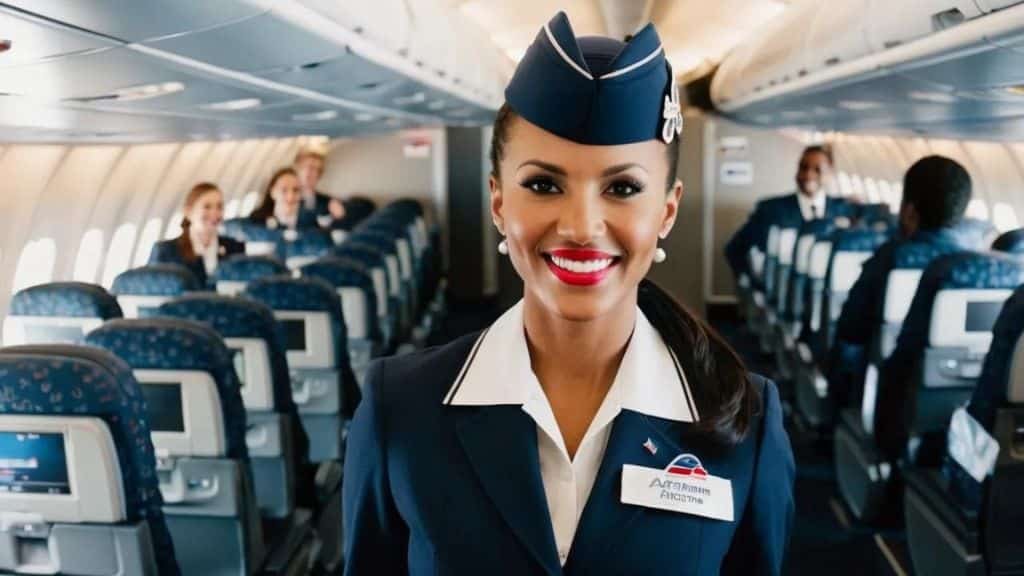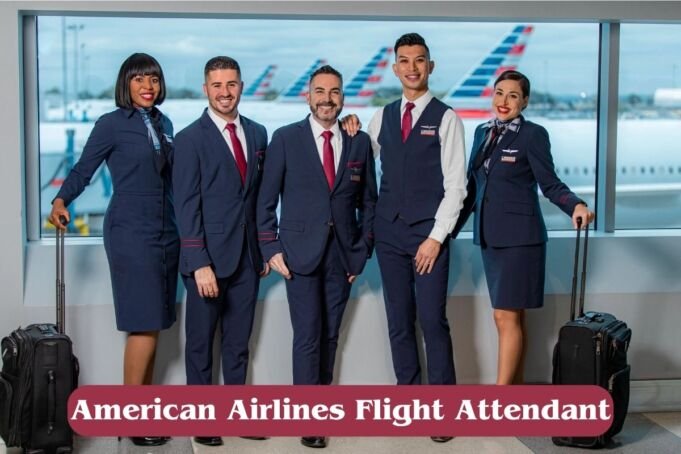Looking to become an American Airlines flight attendant? This piece has all the information you need. American Airlines, a major United States airline, has been a prominent name in the aviation industry for decades. Founded in 1926, it has grown into one of the world’s largest airlines, servicing a vast network of domestic and international routes. Known for its commitment to innovation and customer service, American Airlines has played a significant role in shaping the modern airline industry.
Flight attendants are the face of any airline, acting as the primary point of contact between the airline and its passengers. Their responsibilities extend beyond serving food and beverages; they are trained professionals responsible for passenger safety, comfort, and experience during flights. In the dynamic environment of an aircraft, flight attendants ensure adherence to safety protocols, manage in-flight services, and provide assistance to passengers, playing a pivotal role in maintaining the airline’s reputation and service standards.
History and Evolution of American Airlines Flight Attendants
The profession of flight attendants at American Airlines began in the early years of commercial aviation. Initially, the role was primarily focused on passenger safety and was often filled by nurses, as their medical knowledge was seen as essential for dealing with potential in-flight emergencies.
Over the years, the role of American Airlines flight attendants has evolved significantly. From being safety supervisors and caregivers, they have become quintessential ambassadors of the airline’s brand. Their role has expanded to include providing a high level of customer service, managing in-flight entertainment, and ensuring a comfortable experience for all passengers.
American Airlines has been a pioneer in several aspects of the flight attendant profession. It was among the first airlines to introduce stewardesses, now known as flight attendants. The airline has been part of significant milestones, such as the integration of male flight attendants and the relaxation of stringent age and appearance requirements, reflecting broader societal changes.
Related Read: Delta Flight Attendant
American Airlines Flight Attendant Requirements
Candidates aspiring to become an American Airlines flight attendant must meet the following criteria:
- Possession of a high school diploma or a General Educational Development (G.E.D.) certificate, along with further adult education, such as programs offered by The Travel Academy.
- Height requirements are specific, with candidates needing to be between 5 feet 2 inches and 6 feet tall.
- Applicants must be a minimum of 19 years old.
- Proficiency in the English language is a necessity.
- Vision requirements stipulate having 20/30 vision, either naturally or corrected through the use of glasses or contact lenses.
- A proportional relationship between height and weight.
- The physical capability to swim at least 50 feet.
Application Procedure for American Airlines Flight Attendants
To begin your journey as an American Airlines flight attendant, the first step is to meet the necessary qualifications. Following this, the application process can be initiated.
Applicants have the convenience of using their LinkedIn profiles to apply and initiate the application procedure. This method also allows candidates to join American Airlines’ talent network and receive notifications about job opportunities.
Upon creating an account with American Airlines, applicants have the opportunity to upload their resume and cover letter. There’s also a provision to add and upload references.
The application includes several sections that require information about your work experience, educational background, any certifications, language skills, and your willingness to relocate. It’s important to note that being open to relocation is a critical requirement for flight attendant applicants.
Training Programs and Their Components
Once selected, new flight attendants undergo a rigorous training program. This training covers a wide range of topics, including:
- Safety Procedures: Flight attendants are extensively trained in emergency procedures, first aid, and aircraft-specific safety measures.
- Customer Service: Training in customer service skills is essential to ensure that flight attendants can provide a pleasant and comfortable experience for passengers.
- Special Assistance: Training also includes handling special situations like assisting passengers with disabilities, unaccompanied minors, or those with special medical needs.
This training ensures that American Airlines flight attendants are well-equipped to handle the diverse and challenging situations they may face while ensuring passenger safety and satisfaction.
Read Also: Southwest Airlines Flight Attendants
Daily Responsibilities and Duties
1. Pre-flight Preparations
Before each flight, American Airlines flight attendants engage in meticulous pre-flight preparations. This includes attending briefings on flight details, weather conditions, and passenger information. They also inspect safety equipment, ensure the aircraft is clean and properly stocked with food and beverages, and review emergency procedures.
2. In-flight Duties
- Safety Procedures: During the flight, their primary responsibility is to ensure passenger safety. This involves demonstrating safety procedures, monitoring the cabin for any security or safety issues, and being prepared to manage emergencies.
- Customer Service: Flight attendants provide a high level of customer service, including serving meals and beverages, answering passenger queries, and ensuring overall comfort.
- Special Assistance: They offer assistance to passengers with special needs, such as unaccompanied minors, elderly travelers, or those with disabilities.
3. Post-flight Responsibilities
After landing, flight attendants assist with the disembarkation process, ensuring a safe and orderly exit. They also conduct a final check of the cabin to secure equipment and report any issues or irregularities to ground staff.
Uniforms and Appearance Standards

The uniforms of American Airlines flight attendants have evolved significantly over the years. Initially designed for functionality, they have transformed to reflect changes in fashion trends, societal norms, and the airline’s branding. From conservative dresses and hats in the early days to more modern, stylish, and practical attire, these uniforms have been a symbol of the airline’s identity and professionalism.
1. Current Uniform Standards and Requirements
Today, American Airlines uniforms are a mix of style, comfort, and practicality, reflecting the airline’s commitment to a positive image and employee satisfaction. The airline has specific guidelines on attire, grooming, and accessories, ensuring a professional and consistent look that aligns with its brand image.
2. Role of Uniforms in Branding and Professionalism
Uniforms play a crucial role in branding and professionalism. They not only create a visual identity for the airline but also promote a sense of unity and pride among the crew. The professional appearance of flight attendants contributes significantly to the passengers’ perception of the airline’s quality and service standards.
Read More: Philippine Airlines Flight Attendant
Compensation and Benefits for American Airlines Flight Attendants
Working as an American Airlines flight attendant is not only financially rewarding due to a competitive salary, but it also includes a range of additional benefits that enhance the appeal of the job. Here’s an overview of these advantages:
1. Daily Allowance (Per Diem)
Flight attendants are compensated with a per diem allowance, which covers daily expenses such as meals and accommodation while on duty. This ensures that their needs are met during layovers, contributing to their comfort and health.
It’s noteworthy that the per diem rate may differ depending on the layover’s location and duration.
2. Retirement Savings and Profit Sharing
To support long-term financial well-being, American Airlines offers a 401k retirement savings plan for its flight attendants. This plan enables them to invest in their future. In addition, the airline’s profit-sharing scheme allows flight attendants to benefit from the company’s success, receiving a share of the profits based on both individual and company performance.
This arrangement serves as a motivational factor, encouraging staff to contribute effectively to the airline’s success.
3. Travel Benefits
One of the standout perks for flight attendants is the privilege of travel. They, along with their eligible family members, can enjoy reduced fares or sometimes complimentary flights on American Airlines.
This perk enables them to visit new places, accumulate unique experiences, and immerse themselves in diverse cultures, all at a significantly reduced cost. These travel benefits are an excellent way for flight attendants to make the most of their leisure time.
4. Health and Wellness Insurance
American Airlines prioritizes comprehensive health coverage for its employees. Flight attendants have access to various insurance options, including health, dental, and vision. This coverage ensures they have the necessary healthcare resources and protects them against unforeseen medical costs. Additionally, the airline provides life and disability insurance, enhancing the safety net for its staff.
Breakdown of Flight Attendant Salary at American Airlines
Based on information from Glassdoor, a well-known job review website, the estimated annual income for a Flight Attendant at American Airlines is around $35,000. This figure can increase with additional earnings from commissions, stock options, profit sharing, and other bonuses.
1. Base Salary
The basic yearly salary for a Flight Attendant at American Airlines is approximately $35,000, which averages out to about $2,917 monthly. It’s important to note that this figure is an estimate and can vary depending on the number of flying hours and allowances.
2. Hourly Flying Pay
For newly hired flight attendants at American Airlines, the starting hourly wage is typically between $27 and $28.
3. Layover Allowance
The airline offers a per diem allowance for layovers, which is about $2.20 per hour for domestic flights within the United States and $2.50 per hour for international flights. This per diem allowance is consistent for all flight attendants regardless of their tenure, meaning every crew member on the same flight receives the same rate.
Overall, the total monthly earnings for a flight attendant at American Airlines can range from $35,000 to $50,000 annually.
Also Read: Flight Attendant Salary
Flight Attendant Culture and Community
The culture among American Airlines flight attendants is one of camaraderie, professionalism, and a shared commitment to excellence in service. These professionals embody the airline’s values, balancing the demands of safety and customer service with grace and efficiency. This culture is nurtured through a strong sense of belonging, continuous training, and a shared passion for travel and connecting with people from diverse backgrounds.
The flight attendant community at American Airlines is underpinned by robust support systems. These include professional development programs, wellness initiatives, and peer support networks. The airline fosters a nurturing environment where flight attendants can grow professionally and personally. Regular team-building activities and internal communication platforms also strengthen their sense of community and belonging.
Frequently Asked Questions (FAQs)
How much do flight attendants make with American Airlines?
As of January 3, 2024, the average yearly income for a flight attendant in the American Airlines category across the United States is $47,079. For a more straightforward understanding, this equates to about $22.63 per hour. In weekly terms, it’s approximately $905, or monthly, around $3,923.
Do you need a degree to be a flight attendant for American Airlines?
To qualify as a flight attendant with American Airlines, candidates need at least a high school diploma or GED. Additionally, they should have either two years of post-high school education or experience in a role involving public contact, or specific flight attendant training like that offered by The Travel Academy. Experience in customer service is also highly valued.
How many hours do flight attendants work?
Flight attendants typically work between 30 to 40 hours per week. However, the actual hours can vary. Factors influencing this include the airline they work for, the duration of flights they are assigned to (short, medium, or long-haul), and any unforeseen circumstances that may arise. Generally, more consistent and regular hours are found with short-haul flights.
What are the minimum qualifications to become a flight attendant with American Airlines?
A: To qualify, you need a high school diploma or GED, and preferably two years of post-high school education or experience in a public contact role. Specific flight attendant training, like that from The Travel Academy, is a plus. Customer service experience is also highly valued.
Do I need to be able to swim to become a flight attendant at American Airlines?
Yes, the ability to swim at least 50 feet is a requirement for flight attendants at American Airlines, ensuring safety in the event of a water landing or emergency.
Conclusion
American Airlines Flight attendants play a crucial role in ensuring passenger safety and enhancing the travel experience. Their responsibilities go far beyond the cabin, embodying the values and image of the airline. They are the frontline ambassadors of American Airlines, directly impacting customer satisfaction and loyalty.
The flight attendant profession, especially at a leading airline like American Airlines, significantly shapes the airline industry and passenger experience. These professionals are key to balancing operational efficiency with exceptional service, directly affecting the airline’s reputation and success. As the industry evolves, so too will the role of flight attendants, continuing to be an indispensable part of the airline industry’s future.
















[…] Read: American Airlines Flight Attendant […]
[…] Related: American Airlines Flight Attendant […]
Comments are closed.